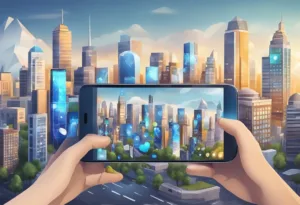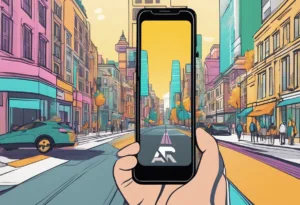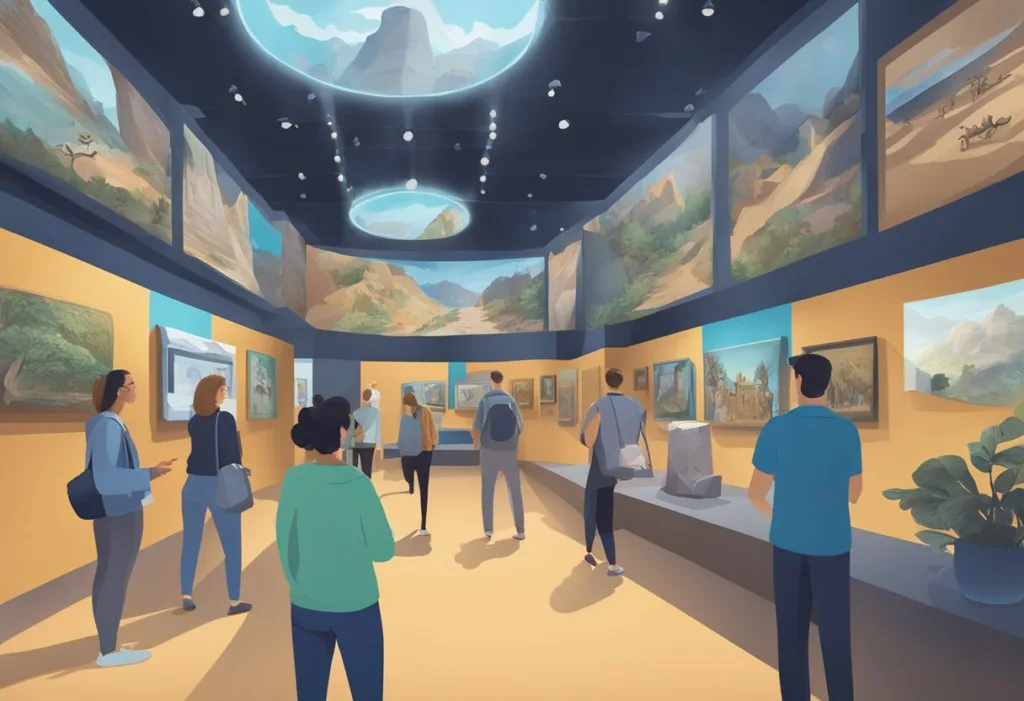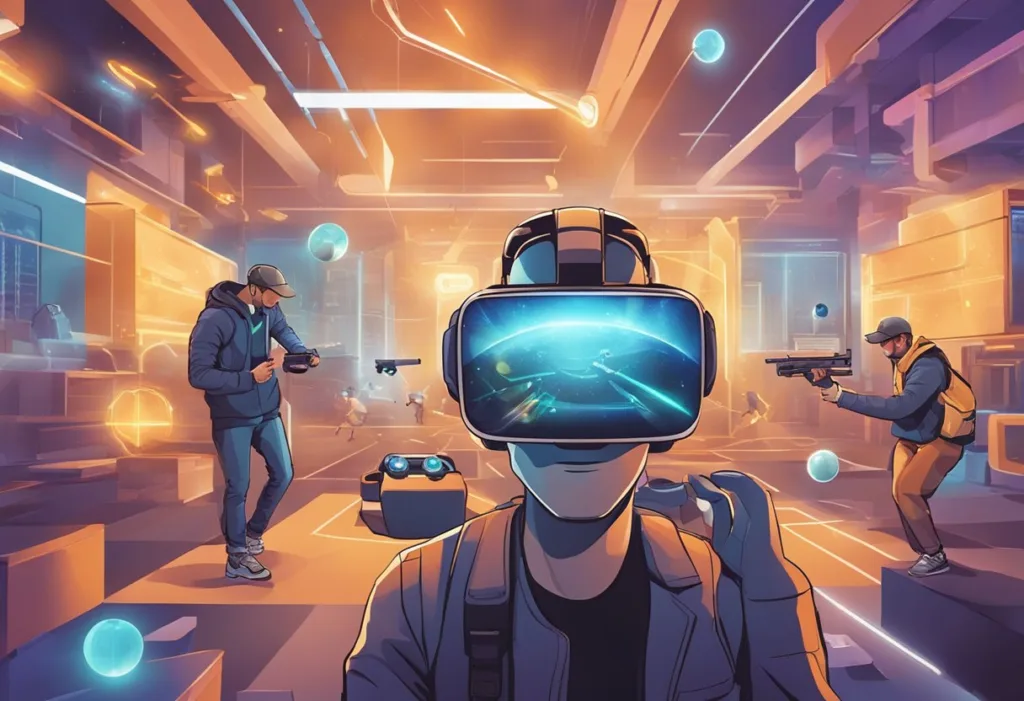Augmented reality (AR) is a technology that superimposes a computer-generated virtual enhancement on a user’s view of the real world. It has become an emerging trend within marketing and sales strategies, allowing brands to give their customers unique experiences with the convenience of tapping into their mobile devices. With mobile becoming one of the most significant media types through which consumers interact with brands and make purchase decisions, AR is set to change the way marketing is done. In this blog post, I will share with you 15 benefits of AR in marketing and case studies of successful AR marketing campaigns.
AR has the potential to revolutionize marketing by creating immersive experiences that engage consumers in new and exciting ways. For example, AR can be used to create interactive product demos, allowing customers to visualize and experience products before making a purchase. AR can also be used to create branded games and experiences that customers can engage with, increasing brand awareness and loyalty.
Evolution of AR in Marketing
Augmented Reality (AR) has been around for a while, but only recently has it become a buzzword in the marketing world. AR technology has the potential to transform the way businesses engage with their customers, creating immersive and interactive experiences that can drive sales and build brand loyalty. In this section, we’ll explore the role of AR in sales and marketing, as well as how AR marketing works.
Role of AR in Sales and Marketing
AR is a technology that overlays digital information onto the real world, creating a blended experience that enhances the user’s perception of reality. In marketing, AR can be used to create interactive experiences that engage customers and drive sales. For example, the popular mobile game “Pokemon Go” used AR to create a game that was played in the real world, driving millions of downloads and generating billions of dollars in revenue.
AR can also be used to create interactive product demonstrations, allowing customers to see how a product works in real-time. For example, car manufacturers can use AR to create virtual showrooms that allow customers to explore different models and features. SnapChat filters are another example of AR in marketing. SnapChat filters allow users to overlay digital content onto their photos and videos, creating a fun and engaging experience that can be shared with friends and family.
15 Benefits Of AR In Marketing

- Enhanced Customer Engagement
- Improved Brand Awareness
- Personalized Shopping Experiences
- Increased Online Conversion Rates
- Memorable Product Demonstrations
- Interactive Advertising Campaigns
- Real-time Product Visualization
- Greater Accessibility to Product Information
- Innovative Storytelling Techniques
- Seamless Integration with Social Media
- Data-Driven Customer Insights
- Reduced Return Rates
- Competitive Differentiation
- Cost-Effective Marketing Solutions
- Sustainable Marketing Practices
Enhanced Customer Engagement
Augmented Reality (AR) technology significantly boosts customer engagement by creating interactive and immersive experiences. For instance, Sephora’s Virtual Artist app allows customers to try on makeup virtually, which not only entertains but also engages them in the product selection process. Similarly, Nike has used AR to engage customers by enabling them to unlock exclusive content and products through the Nike SNKRS app. These experiences encourage users to spend more time with the brand, deepening their connection and increasing the likelihood of purchase.
Improved Brand Awareness
AR campaigns can significantly amplify brand awareness by offering unique and shareable experiences. Pepsi’s AR bus shelter campaign created a buzz by surprising consumers with unexpected scenarios, leading to widespread media coverage and social sharing. Lacoste’s “LCST Lacoste AR” app provided a novel way to try on shoes virtually, garnering attention and increasing brand visibility. These memorable experiences help brands stand out in crowded markets and can quickly go viral, reaching a broad audience.
Personalized Shopping Experiences
AR allows brands to offer personalized shopping experiences, catering to individual customer preferences and needs. Timberland’s virtual fitting room lets shoppers see themselves in different outfits without the need for physical try-ons. Converse’s Sampler app enables customers to visualize how different shoe styles would look on their feet by simply pointing their smartphone camera at their leg. This level of personalization enhances the shopping experience and can lead to greater customer satisfaction.
Increased Online Conversion Rates
By providing customers with a better understanding of how products will look or fit in their own environment, AR can lead to higher online conversion rates. IKEA’s Place app lets customers visualize furniture in their homes, reducing uncertainty and increasing the likelihood of online purchases. Wayfair’s View in Room 3D feature serves a similar purpose, allowing users to place full-scale 3D models of furniture in their rooms before buying. Such tools help minimize doubts that might otherwise prevent an online sale.
Memorable Product Demonstrations
AR transforms product demonstrations into memorable experiences. For example, the Hyundai Virtual Guide app turns vehicle manuals into interactive 3D demonstrations, making information more accessible and engaging. Mercedes-Benz has used AR to enhance their vehicle demonstrations, providing potential customers with a memorable and informative experience that showcases the innovation and features of their cars.
Interactive Advertising Campaigns
Interactive AR advertising campaigns capture consumer attention in ways traditional ads cannot. McDonald’s created an AR game that turned tray liners into virtual racetracks, engaging customers during their visit. Similarly, Coca-Cola and WWF partnered to create an AR experience in the Science Museum in London, which raised awareness about the protection of polar bears and their habitat. These campaigns provide a fun and engaging way to interact with consumers, leaving a lasting impression.
Real-time Product Visualization
AR enables real-time product visualization, allowing customers to see products in their intended environment before making a purchase. Home improvement retailers like Lowe’s use AR to help customers visualize how appliances and furniture would look in their homes. Sherwin-Williams’ ColorSnap Visualizer allows customers to see how different paint colors will look on their walls, helping them make more informed decisions.
Greater Accessibility to Product Information
AR provides greater accessibility to product information, making it easier for customers to learn about products. For instance, wine labels from 19 Crimes come to life with AR, telling the stories of the convicts depicted on the bottles. LEGO boxes feature AR that shows the completed set when scanned, providing additional product information in an engaging way. This accessible information helps customers make better-informed purchasing decisions.
Innovative Storytelling Techniques
Brands use AR to employ innovative storytelling techniques that enhance the narrative around their products. Patrón Tequila’s AR experience invites users on a virtual tour of their hacienda and distillery, telling the brand’s story in an immersive way. Jack Daniel’s AR app turns their whiskey bottles into storytellers, sharing the rich history of the brand with users. These storytelling methods can create a more emotional connection with the brand and deepen consumer engagement.
Seamless Integration with Social Media
AR’s seamless integration with social media platforms enables brands to reach audiences where they are most active. Instagram and Snapchat offer branded AR filters and lenses that users can play with and share with their followers. For example, Gucci has released AR shoe try-on filters on Snapchat, and Taco Bell had a massive hit with their Cinco de Mayo-themed lens. These integrations can lead to increased brand reach and engagement on social media.
Data-Driven Customer Insights
AR provides valuable data-driven insights into customer behavior and preferences. Brands can track user interactions with AR experiences to understand what resonates with their audience. This data can inform future marketing strategies and product development. For example, companies like Ray-Ban use virtual try-on data to understand which styles are most popular among different demographics.
Reduced Return Rates
By offering a more accurate representation of products, AR can help reduce return rates for online purchases. CaratLane, a jewelry brand, uses AR to let customers try on earrings and necklaces virtually, which helps ensure the pieces meet their expectations. As a result, customers are less likely to return items due to a mismatch between the product and their expectations.
Competitive Differentiation
AR can provide a competitive edge by differentiating a brand from its competitors through innovative marketing tactics. For example, Zara’s AR displays in select stores offer a unique experience that sets them apart from other fashion retailers. Similarly, Burberry’s AR experiences in their flagship stores create a high-tech, luxury shopping experience that distinguishes them from other high-end brands.
Cost-Effective Marketing Solutions
AR can be a cost-effective marketing solution, as digital content is often less expensive to produce and update than physical marketing materials. For instance, AR-enabled catalogs reduce the need for physical samples, as seen with the IKEA Place app. This not only cuts down on printing costs but also allows for quick updates to product lines and information.
Sustainable Marketing Practices
AR supports sustainable marketing practices by reducing the need for physical materials. By using AR for virtual product trials, brands like Modiface are reducing the environmental impact associated with manufacturing and disposing of sample products. This environmentally friendly approach can also appeal to eco-conscious consumers who value sustainability in the brands they support
How AR Marketing works
AR marketing works by using a combination of hardware and software to create an immersive and interactive experience. The hardware required for AR marketing varies depending on the application, but typically involves a smartphone or tablet equipped with a camera and sensors.
The software used for AR marketing typically involves a combination of computer vision, machine learning, and 3D modeling. This software is used to detect and track real-world objects, overlay digital content onto the real world, and create interactive experiences that engage customers.
One of the most famous examples of AR marketing was during Super Bowl LII, where Pepsi used AR to create an interactive experience that allowed fans to take photos with NFL players. This experience was created using a combination of AR technology and social media, allowing fans to share their photos with friends and family.
AR is an emerging technology that has the potential to transform the way businesses engage with their customers. By creating immersive and interactive experiences, AR can drive sales, build brand loyalty, and create a memorable experience that customers will remember for years to come.
AR Technology and Its Impact on Consumer Engagement
Augmented Reality (AR) technology has revolutionized the way businesses interact with their customers. By providing immersive experiences, AR technology has become a key tool for marketers to enhance customer engagement. In this section, we will explore how AR technology impacts customer engagement and how it can help businesses improve customer experience.
Understanding AR Experiences
AR experiences are immersive and interactive, allowing customers to engage with products or services in a unique way. AR technology overlays digital elements onto the real world, creating an enhanced experience that engages the customer’s senses. By providing an interactive experience, businesses can increase customer engagement and improve brand loyalty.
AR technology can be used in various marketing campaigns such as product launches, events, and promotions. It allows businesses to showcase their products, services, and brand in a unique and engaging way. By providing an immersive experience, businesses can create a lasting impression on customers, which can lead to increased sales and brand loyalty.
Enhancing Customer Experience with AR
AR technology can enhance customer experience by providing an immersive experience that engages the customer’s senses. By using AR technology, businesses can create an interactive experience that allows customers to visualize products or services in a real-world environment. This allows customers to make informed decisions about the product or service they are interested in.
AR technology can also be used to provide additional information about products or services. By overlaying digital elements onto the real world, businesses can provide customers with additional information about their products or services. This can include product specifications, pricing, and availability.
Integrating AR in Marketing Strategies
Augmented Reality (AR) has become an emerging trend within marketing and sales strategies. It allows brands to give their customers unique experiences with the convenience of tapping into their mobile devices. AR technology offers a new way for marketers to engage with customers, increase brand awareness and drive sales. Here are some ways that AR can be integrated into marketing strategies.
AR in Advertising and Branding
AR can be used in advertising and branding to create interactive and immersive experiences for consumers. Brands can use AR to create unique and memorable experiences that captivate consumers and create a lasting impression. AR technology can be used to create engaging advertisements that stand out from traditional ads. AR can also be used to create virtual showrooms, allowing customers to explore products in a virtual environment.
AR in Retail and Shopping Experiences
AR can be used in the retail industry to create immersive shopping experiences for customers. AR technology can be used to create virtual try-on experiences, allowing customers to see how products will look on them before making a purchase. AR can also be used to create interactive product displays, allowing customers to explore products in a virtual environment. AR technology can also be used to create gamified shopping experiences, encouraging customers to engage with products and brands.
Incorporating AR into marketing strategies can create a unique and engaging experience for customers, increasing brand awareness and driving sales. With the rapid adoption of AR technology, it is important for marketers to consider integrating AR into their marketing strategies to stay ahead of the competition.
Case Studies: Successful AR Marketing Campaigns

Augmented reality (AR) technology has become an increasingly popular tool for marketers to engage customers and increase sales. In this section, we will explore some of the most successful AR marketing campaigns to date.
IKEA Place App and Its Market Influence
IKEA Place App is a prime example of how AR can be used to revolutionize the way customers shop. The app uses AR technology to allow customers to visualize how furniture would look in their home before making a purchase. This not only increases customer confidence in their purchase but also reduces the number of returns and exchanges.
Since the launch of the app, IKEA has seen a significant increase in sales. In the first six months, the app was downloaded over 2.5 million times, and IKEA reported a 98% customer satisfaction rate. The app has also received numerous awards, including the 2018 Cannes Lions Grand Prix for Creative Effectiveness.
How Sephora and Timberland Utilize AR
Sephora and Timberland are two other brands that have successfully leveraged AR technology in their marketing campaigns. Sephora’s Virtual Artist app allows customers to try on makeup virtually and experiment with different looks. This has not only increased customer engagement but also led to a 3.5% increase in sales for the brand.
Timberland’s AR campaign, on the other hand, allowed customers to visualize how their boots would look in different environments. This not only increased customer confidence in their purchase but also led to a 73% increase in online sales.
These case studies demonstrate the potential of AR technology to transform the way customers shop and interact with brands. By leveraging AR in their marketing campaigns, brands can increase customer engagement, boost sales, and differentiate themselves from the competition.
Challenges and Considerations in AR Marketing
Augmented Reality (AR) is a cutting-edge technology that has the potential to revolutionize the way businesses market their products and services. However, there are several challenges and considerations that businesses need to keep in mind while investing in AR marketing. In this section, we will discuss some of the technical and investment challenges as well as user adoption and data privacy concerns that businesses need to consider while implementing AR marketing strategies.
Technical and Investment Challenges
One of the biggest challenges of AR marketing is the technical complexity involved in developing and implementing AR applications. AR requires high-quality graphics, advanced algorithms, and reliable hardware to function effectively. This means that businesses need to invest in expensive hardware and software to develop AR applications. Businesses need to hire skilled professionals who can develop and maintain AR applications. This can be a significant investment, especially for small and medium-sized businesses.
Another technical challenge of AR marketing is the need for high-speed internet connections and powerful mobile devices. AR applications require high-speed internet connections to function effectively, and users need powerful mobile devices to run AR applications smoothly. This means that businesses need to ensure that their target audience has access to high-speed internet connections and powerful mobile devices.
User Adoption and Data Privacy
User adoption is another challenge that businesses need to consider while implementing AR marketing strategies. AR is a relatively new technology, and not all users may be familiar with how it works. This means that businesses need to invest in educating their target audience about AR and how it can benefit them. Businesses need to ensure that their AR applications are easy to use and provide a seamless user experience.
Data privacy is another concern that businesses need to keep in mind while implementing AR marketing strategies. AR applications collect a significant amount of user data, including location data, browsing history, and personal preferences. This data can be used to create personalized marketing campaigns, but it also raises privacy concerns. Businesses need to ensure that they are transparent about how they collect, store, and use user data. They also need to ensure that they comply with data privacy regulations to avoid legal issues.
While AR marketing has several benefits, businesses need to consider several challenges and considerations before investing in AR marketing strategies. Technical and investment challenges, user adoption, and data privacy concerns are some of the key factors that businesses need to keep in mind while implementing AR marketing strategies.
Frequently Asked Questions
How can augmented reality enhance a marketing strategy?
Augmented reality (AR) can enhance a marketing strategy by providing an interactive and engaging experience for customers. With AR, brands can create immersive experiences that allow customers to interact with products in a virtual environment. This can enhance customer engagement, increase brand awareness, and ultimately lead to higher sales. AR can also provide valuable data insights into customer behavior, helping brands to optimize their marketing strategies.
What are some successful examples of AR in marketing campaigns?
Some successful examples of AR in marketing campaigns include IKEA’s AR app that allows customers to preview furniture in their home before purchasing, and Pepsi’s AR campaign that allowed customers to interact with virtual objects and win prizes. Another example is the AR campaign by cosmetics brand L’Oreal, which allowed customers to virtually try on makeup products before making a purchase.
What benefits does augmented reality offer to businesses in terms of marketing?
Augmented reality offers several benefits to businesses in terms of marketing. AR can increase customer engagement and brand awareness, provide valuable data insights into customer behavior, and create a more memorable and personalized experience for customers. AR can also help businesses to differentiate themselves from competitors and drive sales by providing a unique and innovative marketing strategy.
How do brands integrate AR into their advertising efforts?
Brands can integrate AR into their advertising efforts by creating AR experiences that are relevant and engaging to their target audience. This can include creating AR ads that allow customers to interact with products, or creating AR experiences that provide additional information or entertainment value. Brands can also partner with AR technology providers to create custom AR experiences that align with their marketing goals.
In what ways can AR be utilized within digital marketing?
AR can be utilized within digital marketing in several ways. This includes creating AR ads that allow customers to interact with products, creating AR experiences that provide additional information or entertainment value, and creating AR experiences that allow customers to virtually try on products before making a purchase. AR can also be used to create immersive brand experiences that can be shared on social media, increasing brand awareness and engagement.
What is the role of augmented reality in shaping consumer experiences?
The role of augmented reality in shaping consumer experiences is to provide an immersive and engaging experience that allows customers to interact with products in a virtual environment. AR can create a more memorable and personalized experience for customers, increasing brand loyalty and ultimately driving sales. AR can also provide valuable data insights into customer behavior, helping brands to optimize their marketing strategies and create more effective campaigns.














